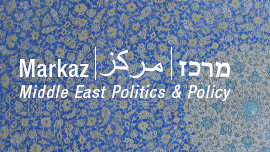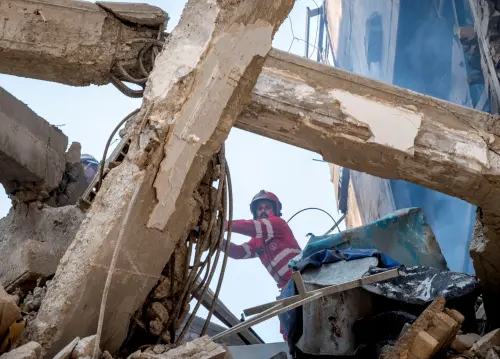Content from the Brookings Doha Center is now archived. In September 2021, after 14 years of impactful partnership, Brookings and the Brookings Doha Center announced that they were ending their affiliation. The Brookings Doha Center is now the Middle East Council on Global Affairs, a separate public policy institution based in Qatar.
“If the Americans and their regional allies want to pass through the Strait of Hormuz and threaten us, we will not allow any entry,” said deputy commander of Iran’s Revolutionary Guards, Hossein Salami, last Wednesday. Iran has a long history of making threats against this critical waterway, through which some 17 million barrels of oil exports pass daily, though it has not carried them out. But multiple regional security threats highlight threats to energy transit from and through the Middle East and North Africa (MENA)—and demand new thinking about solutions.
Weak spots
Hormuz attracts attention because of its evident vulnerability. But recent years have seen severe disruptions to energy flows across the region: port blockades in Libya; pipeline sabotage in Egypt’s Sinai, Yemen, Baluchistan in Pakistan, and Turkey’s southeast; attacks on oil and gas installations across Syria and Iraq; piracy off Somalia. Energy security is threatened at all scales, from local community disturbances and strikes, up to major regional military confrontations.
Of course, it would be best to mitigate these energy security vulnerabilities by tackling the root causes of conflict across the region. But while disruption and violence persist, energy exporters and consumers alike should guard against complacency.
##1##
A glut of oil and gas supplies globally—with low prices, growing U.S. self-sufficiency, and the conclusion of the Iranian nuclear deal—may seem to have reduced the urgency: markets have hardly responded to recent flare-ups. But major economies – even the United States – still remain dependent, directly or indirectly, on energy supplies from the MENA region. Spare oil production capacity is at unusually low levels, leaving the balance vulnerable to even a moderate interruption.
Most concern has focused on oil exports, given their importance to the world economy. But the security of liquefied natural gas (LNG) shipments is an under-appreciated risk, particularly for countries such as Japan and South Korea which are heavily dependent on LNG. A disruption would also have severe consequences for countries in the Middle East and North Africa, depriving them not only of revenues but potentially of critical imports.
Doing better
There are three broad groups of approaches to mitigating the risk of energy transit disruptions: infrastructure, institutions, and market.
- Infrastructure includes the construction of bypass pipelines avoiding key choke-points and strategic storage.
Existing bypass pipelines include SUMED (which avoids the Suez Canal); the Habshan-Fujairah pipeline in the UAE (bypassing Hormuz); and the Saudi Petroline, which runs to the Red Sea, hence offering an alternative to the Gulf and Hormuz. Proposed projects include a link from other Gulf Cooperation Council (GCC) countries to Oman’s planned oil terminal at Duqm on the Indian Ocean; new or rehabilitated pipelines from Iraq across Jordan and Turkey; an expansion of Petroline; and a new terminal in southern Iran at Jask.
Strategic storage can be held by oil exporters, by importers, or a combination (in which exporters hold oil close to their customers’ territory, as with arrangements between Saudi Arabia and Japan, and between Abu Dhabi and Japan and India).
- Institutional approaches include mechanisms to deal with disruptions, such as cooperative sharing arrangements.
More analysis has focused on infrastructure than on institutional and market mitigation. Yet these approaches have to work together. Physical infrastructure is not enough: it has to be embedded in a suitable framework of regulation, legislation, and diplomacy. Cross-border or multilateral pipelines require agreements on international cooperation; strategic storage is most effective when rules for its use are clear, and when holders of storage agree not to hoard scarce supplies.
The effective combination of infrastructure and institutions has a strategic benefit even if it is never used. By making oil exporters and consumers less vulnerable to threats, it makes it less likely that such threats will be carried out.
Alliances can be useful for mutual security and coordination. However, they raise the difficult question of whom they are directed against. Mutually-hostile alliances would be a threat to regional energy security rather than a guarantor. Organizations such as the International Energy Agency (IEA), the International Energy Forum (IEF), Organization of Petroleum Exporting Countries (OPEC), Gulf Cooperation Council, and the Association of Southeast Asian Nations (ASEAN) could all have roles, but none is ideally placed. Rather than creating another organization, reaching an understanding between existing bodies may be more effective.
- In general, markets cope well with the task of allocating scarce supplies. Better and timelier data, such as that gathered by the IEF, can greatly improve the functioning of markets. Governments do have a role in protecting the most vulnerable consumers and ensuring sufficient energy for critical services, but price controls, rationing, and export bans have usually been counterproductive, and many of the worst consequences of so-called energy crises have come from well-meaning government interference with the normal market process of adjustment.
However, it is generally difficult or impossible for a single company or country to capture all the benefits of building strategic infrastructure—which, as with a bypass pipeline, may only be required for a few months over a period of decades. International financing, perhaps backed by a major energy importer—mostly likely China—can help support such projects, particularly at a time of fiscal austerity in the Middle East.
Energy exporters within the MENA region may often find their interests divergent. But the field of energy security is one area for more fruitful cooperation—at least between groups of states, and some external players, particularly their increasingly important Asian customers. If regional tensions and conflicts cannot be easily solved, such action at least alleviates one of the serious risks of the region’s turmoil.
For more on this topic, read Robin Mills’ new analysis paper “Risky routes: Energy transit in the Middle East.”
The Brookings Institution is committed to quality, independence, and impact.
We are supported by a diverse array of funders. In line with our values and policies, each Brookings publication represents the sole views of its author(s).




Commentary
Three ways to improve security along the Middle East’s risky energy routes
May 11, 2016